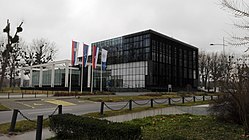University of Novi Sad
University in Serbia From Wikipedia, the free encyclopedia
The University of Novi Sad (Serbian: Универзитет у Новом Саду, Univerzitet u Novom Sadu; Hungarian: Újvidéki Egyetem) is a public university in Novi Sad, Serbia. Alongside nationally prestigious University of Belgrade, University of Novi Sad is one of the most important educational and research institutions in Serbia and South Eastern Europe and the flagship institution of higher education in Vojvodina province.
Универзитет у Новом Саду Univerzitet u Novom Sadu Újvidéki Egyetem | |
 | |
| Type | Public |
|---|---|
| Established | June 28, 1960 |
| Budget | €63.06 million (2020, planned; public funding)[1] |
| Rector | Prof. Dejan Мadić, Ph.D. |
Academic staff | 3,863 (teaching&research staff, academic year 2022/2023) |
Administrative staff | 1,269 (academic year 2022/2023) |
Total staff | 5,198 (academic year 2022/2023) |
| Students | 48,874 (academic year 2022/2023) |
| Address | Dr. Zorana Djindjica 1, Novi Sad , , Serbia 45°14′51.459″N 19°51′14.666″E |
| Campus | University campus |
| Website | www |
 | |
The University of Novi Sad, with almost 50,000 students and more than 5,000 employees, is one of the largest educational and research centers in Central Europe. It belongs to the group of comprehensive universities, which are characterized by providing nearly all fields of science and higher education. It is composed of 14 faculties and three scientific institutes located in four university cities - Novi Sad, Sombor, Subotica and Zrenjanin.
History
Summarize
Perspective
The foundations of higher education in Vojvodina can be traced back to 1740, with the establishment of the Collegium Vissariono-Pawlovicsianum Petrovaradinense seminary in Novi Sad. In 1778, the Norma, a school for the education of Serbian teachers, was founded in Sombor and in 1812, the Preparandija, a teacher training college was founded in Szentendre, whose seat was moved to Sombor in 1816. These institutions were important forerunners to the University of Novi Sad.[6]
The seat of Matica Srpska, the oldest cultural and scientific institution of the Serbian people, was relocated to Novi Sad in 1864. The development of legal sciences and education on the territory of today's Vojvodina was particularly influenced by the Faculty of Law in Subotica, established in 1920.[6] In 1960, the National Assembly adopted the Law on establishment of the University of Novi Sad, which brought together previously founded faculties into a unique academic community of Novi Sad.[6] The University schools that had previously existed in Novi Sad since 1954, the Faculty of Liberal Arts, Agriculture, Law, Medicine, Technology, Economics, Mechanical Engineering, Mathematics and Natural Sciences, were merged into one entity.[7]
Organization
Summarize
Perspective
Faculties and Institutes
The faculties and institutes of the University of Novi Sad are situated in four historic cities of the Autonomous Province of Vojvodina, in the north of the Republic of Serbia. The seat of the university is in Novi Sad, with the central campus situated on the bank of the river Danube, in the vicinity of Petrovaradin Fortress (built in the 18th century), and the old city center.[8]
| # | Faculty | Headquarters | Year of Establishment |
|---|---|---|---|
| 1 | Faculty of Agriculture | Novi Sad | 1954 |
| 2 | Faculty of Philosophy | Novi Sad | 1954 |
| 3 | Faculty of Law | Novi Sad | 1955 |
| 4 | Faculty of Technology | Novi Sad | 1959 |
| 5 | Faculty of Economics | Subotica | 1960 |
| 6 | Faculty of Technical Sciences | Novi Sad | 1960 |
| 7 | Faculty of Medicine | Novi Sad | 1960 |
| 8 | Faculty of Natural Sciences and Mathematics | Novi Sad | 1969 |
| 9 | Academy of Arts | Novi Sad | 1974 |
| 10 | Faculty of Civil Engineering | Subotica | 1974 |
| 11 | Technical Faculty Mihajlo Pupin | Zrenjanin | 1974 |
| 12 | Faculty of Sports and Physical Education | Novi Sad | 1974 |
| 13 | Faculty of Pedagogy | Sombor | 1993 |
| 14 | Teachers' Training Faculty (in Hungarian language) | Subotica | 2006 |
- Faculty of Agriculture
- Faculty of Philosophy
- Faculty of Technology
- Faculty of Economics
- Faculty of Medicine
- Faculty of Natural Sciences and Mathematics
- Academy of Arts
- Faculty of Sports and Physical Education
Studies
Summarize
Perspective
The University of Novi Sad offers around 320 accredited study programs at the level of Bachelor, Master, Specialist and Doctoral studies, carried out at its faculties and within its University Center for Interdisciplinary and Multidisciplinary Studies and Research.[8]
About 56% of students at all study levels studies are women.[9]
Science
Resulting from a special agreement on cooperation, researchers, professors and students have access to the Matica Srpska Library,[10] the oldest Serbian scientific and cultural institution, founded in 1826, which offers more than three million publications.
The University encompasses around 250 laboratories.[11] Of special significance to the strengthening of innovation potential is the Science and Technology Park Novi Sad. With the support of the Faculty of Technical Sciences, around 200 start-up and spin-off companies have been founded,[12] mainly in the IT sector, employing young engineers who graduated from the University of Novi Sad.
Researchers from the University of Novi Sad have been the recipients of numerous international and national awards for technical innovations. The BioSense Institute, one of three research institutes, was proclaimed by the European Union as one of the thirty research institutions in Europe with the greatest potential in the field of bio-technologies. Its project ANTARES was the best ranked in Europe in 2016 within the program Horizon 2020.[8]
In 2009, the Faculty of Law won first place in the moot court competition, which was organized by the University of Leiden at the International Court of Justice in the Hague. The students from the Faculty of Technical Sciences, which continue the tradition of the famous Yugoslav School of Robotics, have been named among the best in Europe, winning first place at the European Competition in Robotics EUROBOT 2019 and EUROBOT 2022, held in France, as well as second and third place in EUROBOT 2016.[8] The students of the Academy of Arts and the Faculty of Sports and Physical Education have received numerous awards at national and international competitions.[8]
Art
The Academy of Arts Novi Sad was founded in 1974 as one of the University of Novi Sad faculties.
Along with its educational and scientific activities, the academy is famous for developing international cooperation with numerous cultural, artistic, and academic institutions. The academy's strength is based on its capacity to develop international projects through various programs such as Erasmus +, Creative Europe, and Horizon 2020.[citation needed]
The Academic Culture and Art Society of the University of Novi Sad "Sonja Marinković" is known for its successful performances at festivals in the country and abroad. Its Accordion Orchestra won the first prize at the World Music Competition in Innsbruck (Austria) in 2013 and is considered to be one of the best in Europe.[8]
Recognition and Accreditation
The University of Novi Sad is accredited by the Commission for Accreditation and Quality Assurance in Serbia. It is listed in the World Directory of Medical Schools and recognized by the World Health Organization.[13]
Notable alumni
- Poets and novelists Dragomir Dujmov, Mihajlo Kažić and Jovan Zivlak,
- American Slavist Wayles Browne,
- Bulgarian linguist Lyubomir Miletich,
- Croatian-American writer Josip Novakovich,
- Serbian-Canadian mathematician and computer scientist Ivan Stojmenovic.
- Serbian Ambassador to Israel Mile Isakov, and
- Hungarian politicians in Serbia Attila Juhász and István Pásztor.
- Bratislav Stankovic, biologist and lawyer, U.S. patent attorney
- Nenad Baroš, politician
- Gojko Palalić, politician
Among the best-known musicians are:
- pianists Rita Kinka, Mladen Čolić and Ratimir Martinović,
- flutist Sanja Stijačić,
- composer Mitar Subotić,
Notable people
- Dorian Leljak, pianist and university professor
See also
References
External links
Wikiwand - on
Seamless Wikipedia browsing. On steroids.










